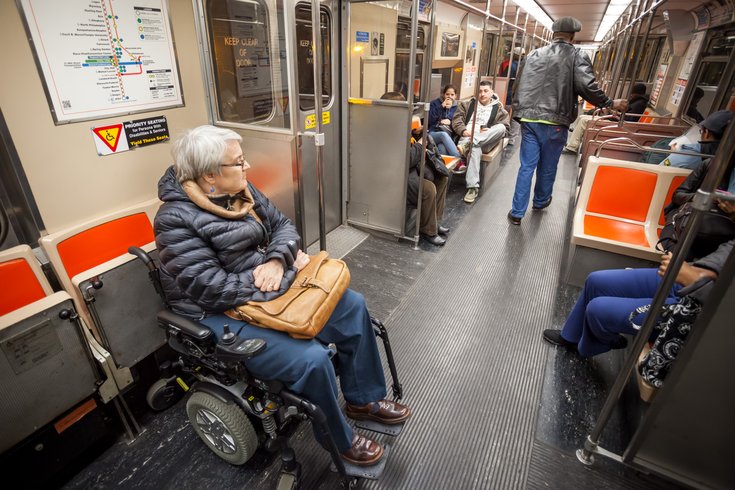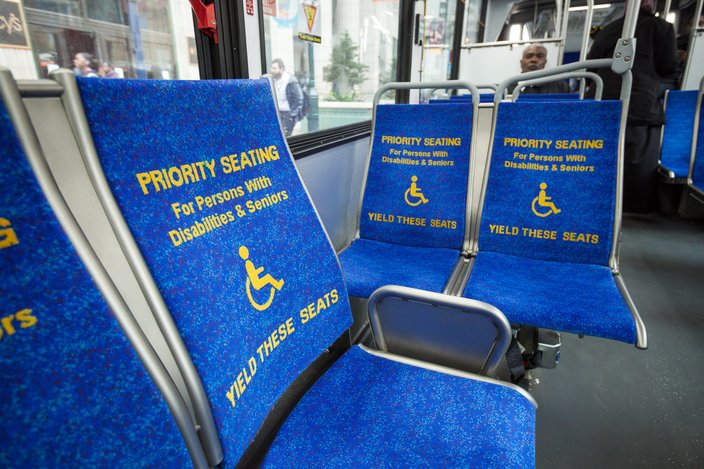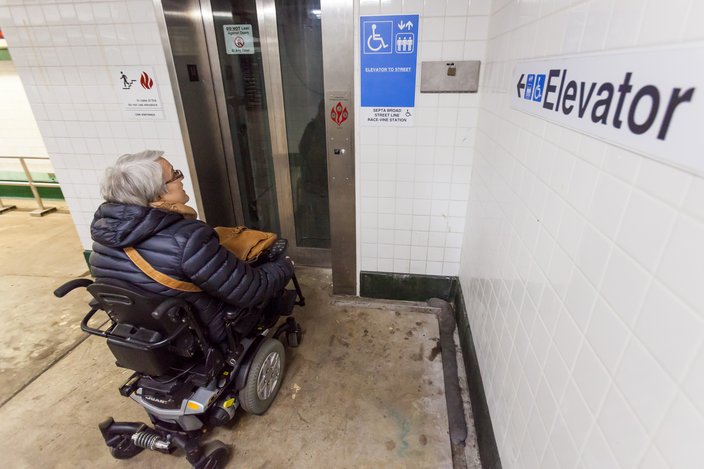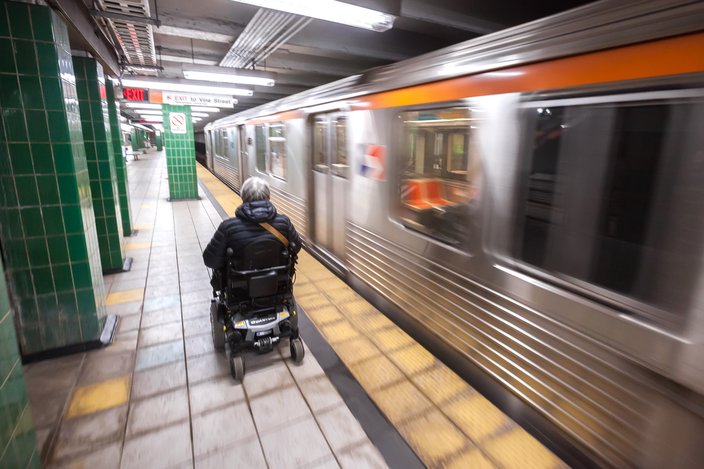
April 06, 2016
 Thom Carroll/PhillyVoice
Thom Carroll/PhillyVoice
Ruth Black commutes to work by taking the northbound Broad Street Line subway on Monday, April 4, 2016. As someone who works with other wheelchair users, Black says it’s important for people to speak up when they cannot access services.
On a wintry day in January, on SEPTA's 42 bus west on Walnut Street, a few passengers wrapped in puffer coats, pea jackets and scarves stepped on and off as the hard snow spit at the windows.
There were only a few passengers – some elderly women up front, a couple of young guys in back and others scattered throughout, including a man in first row seating designated for disabled and elderly riders.
The creaking bus lurched forward in slow-going traffic, then came to a stop. The driver prepared for a woman in a motorized chair to embark. Some riders sighed audibly, but most sat quietly as she came into sight in her chair.
Eager to load the passenger, the bus driver asked the lone man in the priority seating area that can accommodate a wheelchair or scooter if he would be willing to move one row back in the nearly-empty bus. It appeared to be business as usual – the sound of the bus kneeling and the driver getting ready to flip the seat – until the man said, No, he would not move from his seat.
Looking on were several elderly riders sitting across the aisle from him in other priority seats. Two women nearby exchanged looks as a young man a few rows back fingered his phone.
The driver asked a second time if the man would consider moving. Again, the man indicated no.
The woman in the motorized chair – wrapped in a scarf and wearing a wool hat – looked exasperated. It only got worse when the driver told her that she would have to wait for the next bus and then helped her back out into the cold.
When the door closed, sealing off the sounds of the city, the bus was eerily silent. The man who refused to give up his seat stared ahead and the two women whispered quietly to each other. The bus traveled two blocks to the next stop, and the man who would not surrender his seat to a woman in a wheelchair stood up and exited the bus.
 Thom Carroll/PhillyVoice
Thom Carroll/PhillyVoiceSEPTA buses have designated priority seating for seniors and riders with disabilities.
So how can that happen?
On standard SEPTA buses, the first row has three seats facing the aisle, a configuration that accommodates disabled and elderly passengers. The seats are designed so that they can be flipped up to make room for someone, for example, in a wheelchair or scooter.
“The priority seating is reserved for the elderly and disabled,” said Josh Gottlieb, SEPTA’s director of administration and finance, noting the seating complies with federal Americans with Disabilities Act (ADA) regulations.
There is a protocol in place for people who refuse to offer their seats to disabled riders, he said.
“It’s a suggestion for passengers,” Gottlieb says. “We would like people to leave [the seats] open, but there is nothing we can do to make that happen.”
SEPTA discourages drivers from getting into verbal or even physical altercations with uncooperative passengers because another rider's disability may not be obvious, Gottlieb said. Drivers are expected to avoid at all costs any incident that could lead to anger and violence, and to take pains to not offend someone who may be unwilling or able to comfortably move.
“All the operator can do is make a request,” he said. “We can ask, but we can’t insist someone move.”
In many ways the policy is a sign of the times on public transit, along with such aggravations as “man spreading” and people who insist on taking up multiple seats on crowded buses and trains. But signage and federal regulations are no substitute for courtesy and understanding, and there is no guarantee that a rider will close his legs or move a bag onto her lap – or that a disabled passenger will get an accessible seat.
When an incident occurs like the one on the 42 bus, however, drivers are encouraged to follow some common-sense practices, SEPTA administrators said. A driver should not load someone in a wheelchair, for example, onto a bus without first securing an accessible seat. If there is no seat, the driver must then step off the bus to let the person in the wheelchair know and provide a free transfer for the next bus. The driver is also expected to make contact with SEPTA's control center to report the incident and notify the next bus. In some cases a representative may come onsite to assist, ensuring that the passenger is able to access the next available ride in a timely manner.
 Thom Carroll/PhillyVoice
Thom Carroll/PhillyVoiceRuth Black waits for the elevator at the Race / Vine station of the Broad Street Line subway on Monday, April 4, 2016. A majority of Broad Street Line and Regional Rail stations are not wheelchair accessible.
For wheelchair users like Ruth Black who rely on public transportation to get to and from work, having a designated space accessible on each bus or train is critical.
Black, a peer coordinator at Magee Rehabilitation Hospital on Race Street, says that she has been fortunate and that, for the most part, her experiences on SEPTA have been good.
“Drivers thank riders for moving,” Black said, who spends a lot of time on the Broad Street Line. “There’s some assistance that has not been offered to open the big door at the Locust and Walnut stop. But most experienced riders move out of the designated seats.”
As someone who works with other wheelchair users, Black says it’s important for people to speak up when they cannot access services. For example, not all SEPTA drivers strap in scooter and wheelchair users even though they are required to do so.
“When we take patients out we often have to remind the SEPTA driver that they need to be strapped in,” she explained. “And not all stops are accessible.”
“It can be so uplifting to get into a vehicle and go wherever and whenever you want.” – Charles W. Horton Jr., ADA coordinator for Philadelphia
During the Philadelphia visit of Pope Francis in September, many wheelchair users had to travel for blocks to be able to reach a station with accessibility. And interestingly, Dilworth Plaza at City Hall, despite all of its renovations, is still not a wheelchair accessible stop.
“In a perfect world we would have universal design,” said Black, who has encountered broken, out-of-service elevators and a few other hurdles to making the most of her SEPTA experience. When this happens she is forced to cross over and take another train to another accessible station in hopes that the elevator is working at a secondary location. Such obstacles, of course, add a great deal of time to her commute.
“We’re used to it,” she said.
But many people who have the ability to take the stairs or even their pick of seats may not realize the effort it takes to navigate public transportation in a chair.
Charles W. Horton Jr., the executive director and accessibility compliance specialist with the Mayor’s Commission on People with Disabilities, is the ADA coordinator for the City of Philadelphia. A wheelchair user himself, he works with the administration to make sure that disabled people have a voice in City Hall when it comes to issues of education, employment, housing and, of course, transportation.
Transportation is especially important, Horton said, because it allows people to come and go as they please and to take part in the community.
“It can be so uplifting to get into a vehicle and go wherever and whenever you want,” he said, cautioning able-bodied people to be considerate of riders with different abilities. “You never know if you could be in a wheelchair, or your child or parent need help.”
Horton regularly works with SEPTA and other transportation services to ensure that they are in compliance with important ADA guidelines. He recently consulted with Uber on wheelchair-accessible vehicles and an etiquette program that teaches drivers how to interact with people who have a variety of disabilities.
He says other than respecting the ADA guidelines, SEPTA cannot do much more than what they already do (label seats and request that passengers relocate) so that disabled or elderly persons can ride buses and trains. The goal, he said, is to get everyone on board so that having a disability does not preclude someone from accessing vital transportation services in Philly.
Fortunately, there is also an independent committee called SAC, a citizens advisory group that advocates for people with disabilities who ride SEPTA. The group, the oldest of its kind in the country, represents riders and advocates from more than 50 different disability service organizations. They meet on the second Thursday of each month (except August) at SEPTA headquarters at 12th and Market. Even though SEPTA doesn’t technically operate or oversee the group, it does provide a meeting space and ensures that its own representatives are present at all events, which are open to the public. Each month SEPTA reports to SAC and solicits advice and responds to questions and complaints. SAC even provides insights into building new accessible stations.
“They give a voice to people with disabilities to talk about what’s going on and how they can be better supported,” Horton said. He encourages people to also call the local ADA access hotline (215-580-7810) with questions and concerns.
“If you don’t voice opinions and make complaints,” he says, “we don’t have much of a fight. It’s hard to make changes without having a unified voice.”
Walter Fralix uses a wheelchair on SEPTA to navigate Center City, where he lives and works. When the transit agency installed an elevator at the Walnut-Locust stop on the Broad Street Line several years ago, he said he was able to take more advantage of the service. He also uses the huge mezzanine level below the streets that connects Broad Street, Market-Frankford, the Trolley, Regional Rail, and PATCO lines around City Hall.
“During inclement weather, I make extensive use of this mezzanine to get to the line I need,” he said. “On more than one occasion, I've simply used it to travel to a nearby street as to avoid unnecessary exposure to rain, snow, or just frigid temperatures.”
Overall, his experience with SEPTA has been quite good, especially interacting with employees and fellow passengers.
“A few of the elevators from the mezzanine to the platform levels are tucked away and, though there is signage, they’re sometimes difficult to find,” he admitted. “When I first moved here and hadn’t yet gotten my bearings, the gate agents for the Broad Street and Market Frankford Lines were quite helpful in directing me to the platform that I needed to use — once, even escorting me to the platform.”
A plus for Fralix and other wheelchair users is that city trains don’t have a significant gap between the platform and train, making it easier for someone in a chair to enter and exit without assistance. Many stations in the Regional Rail system, however, have a larger gap between the platform and the train, which requires the use of a bridge plate to gain access to and from a train car.
“Of all the public transportation services offered, the bus system is by far the most accessible,” he says. “All of the buses are equipped with built-in ramps and designated seating for people with disabilities. If someone is sitting in that seat, the bus driver has no qualm insisting that passenger move. There have been one or two times where the bus ramp did not work and I had to wait for the next bus to come.”
Using a wheelchair on the Broad Street or Market-Frankford lines, or even Regional Rail, tends to require a bit more forethought. A majority of Broad Street Line and Regional Rail stations are not wheelchair accessible.
“My personal disbelief is there is not one accessible station in South Philly!” Fralix says.
To find out which stations are accessible, you have to go to the SEPTA website and review the line map to determine the nearest accessible station. In the city, this may mean stopping an extra one or two stations away from a destination, and then either wheeling or hiring a secondary form of transportation. Fralix uses his smartphone to research lines and stations before he embarks on a trip.
 Thom Carroll/PhillyVoice
Thom Carroll/PhillyVoiceRuth Black traverses the platform of the Race/ Vine subway station on the Broad Street Line after exiting the northbound train on Monday, April 4, 2016. Black, a peer coordinator at Magee Rehabilitation Hospital, says that, for the most part, her experiences on SEPTA have been good.
Notably, the Regional Rail network (which extends into both Delaware and New Jersey) operates only 66 of more than 150 stations accessibly – and the Norristown Line is not accessible at all.
“When using the Regional Rail lines, those distances increase exponentially due to the larger area those lines cover,” says Fralix, who also checks on the status of working elevators.
“Elevators that make many stations accessible may be temporarily non-operational,” he said. To verify which elevators are broken, you have to again visit the website, and then locate and call the toll-free number that reports any elevator outages, and plan accordingly.
“I realize that transforming an existing public infrastructure of this magnitude is a long-term goal that, for the most part, will not come quickly or cheaply.” – Walter Fralix, wheelchair rider on SEPTA
“SEPTA could definitely place that elevator outage number on a more conspicuous location on their website,” says Fralix. “I would also like to see a page on their website with the locations of future accessible stations and, if they be so bold, projected dates of completion.”
Fralix is a practical person, and seems to understand the planning and economic complexities of upgrading the system, but he is looking forward to better accessibility overall.
“I realize that transforming an existing public infrastructure of this magnitude is a long-term goal that, for the most part, will not come quickly or cheaply,” he said. “A proposed plan for this project made easily and readily available to the public-at-large would, for me at least, be an affirmation that it will eventually be easier to travel throughout our city and its outlying areas.”
According to Cassandra West, SEPTA's manager of program eligibility and regulatory compliance for customized community transportation, more than 100 of 150 active stations are accessible. Compared to other cities like Paris and London, SEPTA is doing great. But compared to Washington D.C,. where all stations and stops are accessible, it could do better.
Recently, SEPTA was named the ninth-best city in the country for public transportation, according to a report by financial technology company SmartAsset. The results were evaluated by commute times, number of users and income, but not accessibility. For riders like Black, Fralix and Horton, the results mean little, especially if you consider that out of more than 50 stations on the Market-Frankford and Broad Street lines alone, as many as 35 percent are not accessible. More than 25 years after ADA took effect, one might expect SEPTA would be a bit further along.
An accessible travel center opened by SEPTA at Suburban Station is being used for travel training for wheelchair users and other disabled people to learn how to board buses and trains, West said. The agency also partners with local schools and universities to educate students about how to navigate the system. It’s progress, but more still needs to happen to give disabled riders equal access.
She says that when SEPTA invests in new trolleys in the next five-to-six years, they, too, will be completely accessible (currently only the Route 15 is accessible). They are also in the midst of a $7.4 million project that will finally install elevators at the 40th and Market Street station, which serves as many as 6,000 riders each weekday and provides important access to multiple bus routes.
SEPTA has also added elevators to the Race-Vine station and is considering other stations, Susquehanna-Dauphin and the AT&T station near the sports complex.
“That little piece of knowledge,” says Fralix, “makes all the extra effort it takes me to get from my home to a friend’s near Broad and Tasker just a little easier to bear.”